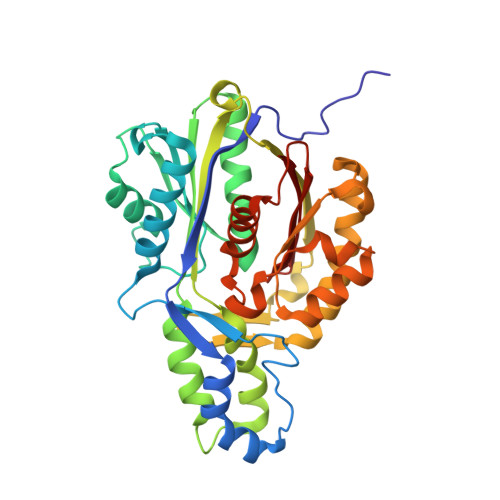Crystal Structures of Xanthomonas campestris OleA Reveal Features That Promote Head-to-Head Condensation of Two Long-Chain Fatty Acids.
Goblirsch, B.R., Frias, J.A., Wackett, L.P., Wilmot, C.M.(2012) Biochemistry 51: 4138-4146
- PubMed: 22524624
- DOI: https://doi.org/10.1021/bi300386m
- Primary Citation of Related Structures:
3ROW, 3S1Z, 3S20, 3S21, 3S23 - PubMed Abstract:
OleA is a thiolase superfamily enzyme that has been shown to catalyze the condensation of two long-chain fatty acyl-coenzyme A (CoA) substrates. The enzyme is part of a larger gene cluster responsible for generating long-chain olefin products, a potential biofuel precursor. In thiolase superfamily enzymes, catalysis is achieved via a ping-pong mechanism. The first substrate forms a covalent intermediate with an active site cysteine that is followed by reaction with the second substrate. For OleA, this conjugation proceeds by a nondecarboxylative Claisen condensation. The OleA from Xanthomonas campestris has been crystallized and its structure determined, along with inhibitor-bound and xenon-derivatized structures, to improve our understanding of substrate positioning in the context of enzyme turnover. OleA is the first characterized thiolase superfamily member that has two long-chain alkyl substrates that need to be bound simultaneously and therefore uniquely requires an additional alkyl binding channel. The location of the fatty acid biosynthesis inhibitor, cerulenin, that possesses an alkyl chain length in the range of known OleA substrates, in conjunction with a single xenon binding site, leads to the putative assignment of this novel alkyl binding channel. Structural overlays between the OleA homologues, 3-hydroxy-3-methylglutaryl-CoA (HMG-CoA) synthase and the fatty acid biosynthesis enzyme FabH, allow assignment of the two remaining channels: one for the thioester-containing pantetheinate arm and the second for the alkyl group of one substrate. A short β-hairpin region is ordered in only one of the crystal forms, and that may suggest open and closed states relevant for substrate binding. Cys143 is the conserved catalytic cysteine within the superfamily, and the site of alkylation by cerulenin. The alkylated structure suggests that a glutamic acid residue (Glu117β) likely promotes Claisen condensation by acting as the catalytic base. Unexpectedly, Glu117β comes from the other monomer of the physiological dimer.
Organizational Affiliation:
Department of Biochemistry, Molecular Biology, and Biophysics, University of Minnesota, Minneapolis, MN 55455, USA.














